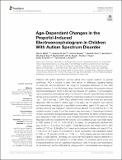Age-Dependent Changes in the Propofol-Induced Electroencephalogram in Children With Autism Spectrum Disorder
Author(s)
Walsh, Elisa C.; Lee, Johanna M.; Terzakis, Kristina; Zhou, David W.; Burns, Sara; Buie, Timothy M.; Firth, Paul G.; Shank, Erik S.; Houle, Timothy T.; Purdon, Patrick L.; Brown, Emery Neal; ... Show more Show less
Downloadfnsys-12-00023.pdf (2.249Mb)
PUBLISHER_CC
Publisher with Creative Commons License
Creative Commons Attribution
Terms of use
Metadata
Show full item recordAbstract
Patients with autism spectrum disorder (ASD) often require sedation or general anesthesia. ASD is thought to arise from deficits in GABAergic signaling leading to abnormal neurodevelopment. We sought to investigate differences in how ASD patients respond to the GABAergic drug propofol by comparing the propofol-induced electroencephalogram (EEG) of ASD and neurotypical (NT) patients. This investigation was a prospective observational study. Continuous 4-channel frontal EEG was recorded during routine anesthetic care of patients undergoing endoscopic procedures between July 1, 2014 and May 1, 2016. Study patients were defined as those with previously diagnosed ASD by DSM-V criteria, aged 2–30 years old. NT patients were defined as those lacking neurological or psychiatric abnormalities, aged 2–30 years old. The primary outcome was changes in propofol-induced alpha (8–13 Hz) and slow (0.1–1 Hz) oscillation power by age. A post hoc analysis was performed to characterize incidence of burst suppression during propofol anesthesia. The primary risk factor of interest was a prior diagnosis of ASD. Outcomes were compared between ASD and NT patients using Bayesian methods. Compared to NT patients, slow oscillation power was initially higher in ASD patients (17.05 vs. 14.20 dB at 2.33 years), but progressively declined with age (11.56 vs. 13.95 dB at 22.5 years). Frontal alpha power was initially lower in ASD patients (17.65 vs. 18.86 dB at 5.42 years) and continued to decline with age (6.37 vs. 11.89 dB at 22.5 years). The incidence of burst suppression was significantly higher in ASD vs. NT patients (23.0% vs. 12.2%, p < 0.01) despite reduced total propofol dosing in ASD patients. Ultimately, we found that ASD patients respond differently to propofol compared to NT patients. A similar pattern of decreased alpha power and increased sensitivity to burst suppression develops in older NT adults; one interpretation of our data could be that ASD patients undergo a form of accelerated neuronal aging in adolescence. Our results suggest that investigations of the propofol-induced EEG in ASD patients may enable insights into the underlying differences in neural circuitry of ASD and yield safer practices for managing patients with ASD.
Date issued
2018-06Department
Institute for Medical Engineering and Science; Massachusetts Institute of Technology. Department of Brain and Cognitive SciencesJournal
Frontiers in Systems Neuroscience
Publisher
Frontiers Research Foundation
Citation
Walsh, Elisa C. et al. “Age-Dependent Changes in the Propofol-Induced Electroencephalogram in Children With Autism Spectrum Disorder.” Frontiers in Systems Neuroscience 12 (June 2018) © 2018 Walsh et al.
Version: Final published version
ISSN
1662-5137